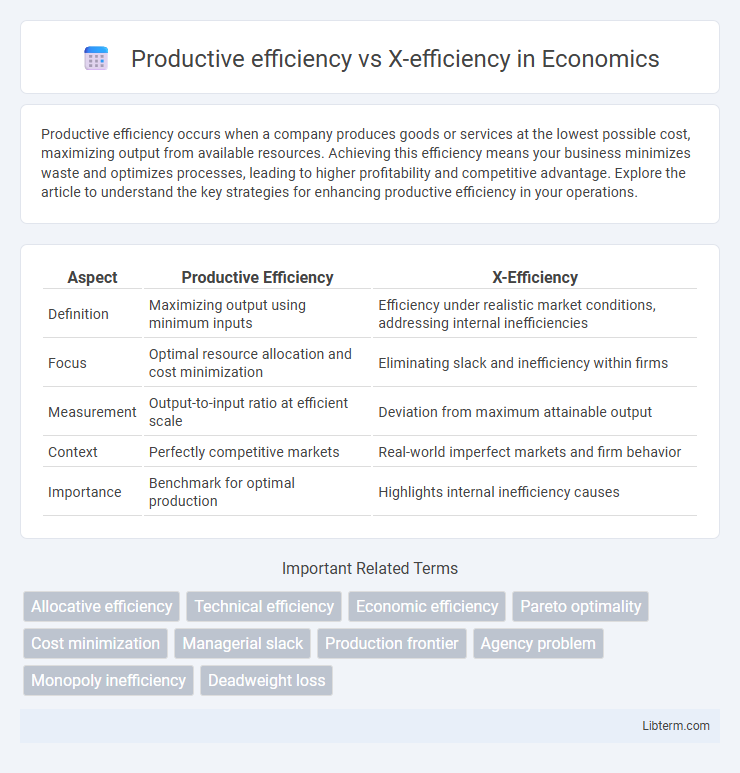Productive efficiency occurs when a company produces goods or services at the lowest possible cost, maximizing output from available resources. Achieving this efficiency means your business minimizes waste and optimizes processes, leading to higher profitability and competitive advantage. Explore the article to understand the key strategies for enhancing productive efficiency in your operations.
Table of Comparison
| Aspect | Productive Efficiency | X-Efficiency |
|---|---|---|
| Definition | Maximizing output using minimum inputs | Efficiency under realistic market conditions, addressing internal inefficiencies |
| Focus | Optimal resource allocation and cost minimization | Eliminating slack and inefficiency within firms |
| Measurement | Output-to-input ratio at efficient scale | Deviation from maximum attainable output |
| Context | Perfectly competitive markets | Real-world imperfect markets and firm behavior |
| Importance | Benchmark for optimal production | Highlights internal inefficiency causes |
Introduction to Productive Efficiency and X-Efficiency
Productive efficiency occurs when a firm produces the maximum output from a given set of inputs, reflecting optimal allocation of resources in a competitive market. X-efficiency measures the degree to which firms minimize waste and operate on their production frontier, considering internal factors like management effectiveness and organizational slack. While productive efficiency assumes firms operate on the production possibilities curve, X-efficiency highlights deviations caused by inefficiencies within firms.
Defining Productive Efficiency
Productive efficiency occurs when a firm produces goods or services at the lowest possible cost, utilizing resources optimally without any waste. It is measured by comparing the actual output to the maximum possible output given the inputs, reflecting the firm's ability to operate on its production possibility frontier. Unlike X-efficiency, which addresses managerial performance and motivation in minimizing inefficiencies, productive efficiency strictly relates to cost minimization and resource allocation.
Understanding X-Efficiency
X-efficiency measures how well firms utilize resources compared to the maximum potential output, highlighting inefficiencies due to organizational slack or lack of competitive pressure. Unlike productive efficiency, which focuses on producing goods at the lowest possible cost using optimal input combinations, X-efficiency captures internal inefficiencies that prevent firms from reaching that optimal frontier. Understanding X-efficiency is crucial for identifying gaps in managerial performance and motivation that traditional efficiency models often overlook.
Key Differences Between Productive Efficiency and X-Efficiency
Productive efficiency occurs when firms produce goods at the lowest possible cost, utilizing resources optimally and ensuring maximum output from given inputs. X-efficiency, however, relates to the degree of efficiency maintained within the firm, emphasizing the internal motivation and effort of employees to minimize waste beyond purely technical factors. The key difference lies in productive efficiency's focus on external cost minimization and resource allocation, while X-efficiency addresses internal organizational dynamics and operational effectiveness.
Measuring Productive Efficiency: Methods and Metrics
Measuring productive efficiency primarily involves analyzing the ratio of output to input using techniques such as Data Envelopment Analysis (DEA) and Stochastic Frontier Analysis (SFA), which identify optimal production frontiers. Key metrics include Total Factor Productivity (TFP), Technical Efficiency Scores, and Cost Efficiency Ratios, enabling firms to benchmark operational performance against best-practice firms. Unlike X-efficiency, which focuses on internal inefficiencies caused by organizational slack or managerial performance, productive efficiency assessments quantify how well resources are transformed into outputs under given technology constraints.
Factors Influencing X-Efficiency in Organizations
X-efficiency in organizations is influenced by factors such as management quality, employee motivation, and organizational structure, which impact how effectively resources are utilized beyond mere cost minimization. Unlike productive efficiency that emphasizes optimal output at minimum input, X-efficiency accounts for internal inefficiencies caused by lack of incentives or poor managerial oversight. Enhancing communication, implementing performance-based incentives, and fostering a culture of innovation significantly reduce X-inefficiency and improve overall organizational performance.
The Role of Competition in Enhancing Efficiency
Competition drives productive efficiency by pushing firms to minimize costs and optimize resource allocation, ensuring goods are produced at the lowest possible average cost. In contrast, X-efficiency highlights inefficiencies within firms due to lack of competitive pressure, where firms may not fully utilize resources or implement best practices. Increased competition reduces X-inefficiency by incentivizing firms to improve internal processes and managerial efficiency, ultimately enhancing overall market efficiency.
Real-World Examples: Productive Efficiency vs X-Efficiency
Productive efficiency occurs when firms produce goods at the lowest possible cost, exemplified by Toyota's lean manufacturing system that minimizes waste and maximizes output. In contrast, X-efficiency reflects the degree of effort firms exert in optimizing resource use, with monopolies like utility companies often showing lower X-efficiency due to lack of competitive pressure. Real-world examples highlight how competitive markets drive productive efficiency, while X-efficiency varies depending on organizational incentives and market structure.
Implications for Economic Policy and Business Strategy
Productive efficiency requires firms to minimize input costs and maximize output, guiding economic policies toward competitive markets and resource allocation optimization, while X-efficiency highlights managerial performance and organizational slack, prompting businesses to improve internal processes and incentivize innovation. Economic policies that foster transparency and reduce market distortions enhance both productive and X-efficiency, enabling sustainable growth. Business strategies centered on benchmarking and performance monitoring help identify inefficiencies and align operational practices with market demands for improved competitiveness.
Conclusion: Maximizing Efficiency for Sustainable Growth
Maximizing productive efficiency ensures optimal use of resources by minimizing costs and achieving the highest possible output, while addressing X-efficiency focuses on reducing inefficiencies caused by lack of competitive pressure or motivation within firms. Sustainable growth relies on balancing both concepts to enhance overall performance, where productive efficiency drives cost-effective production and X-efficiency fosters innovation and responsiveness. Organizations that integrate these approaches can achieve long-term competitiveness and resource sustainability.
Productive efficiency Infographic

 libterm.com
libterm.com